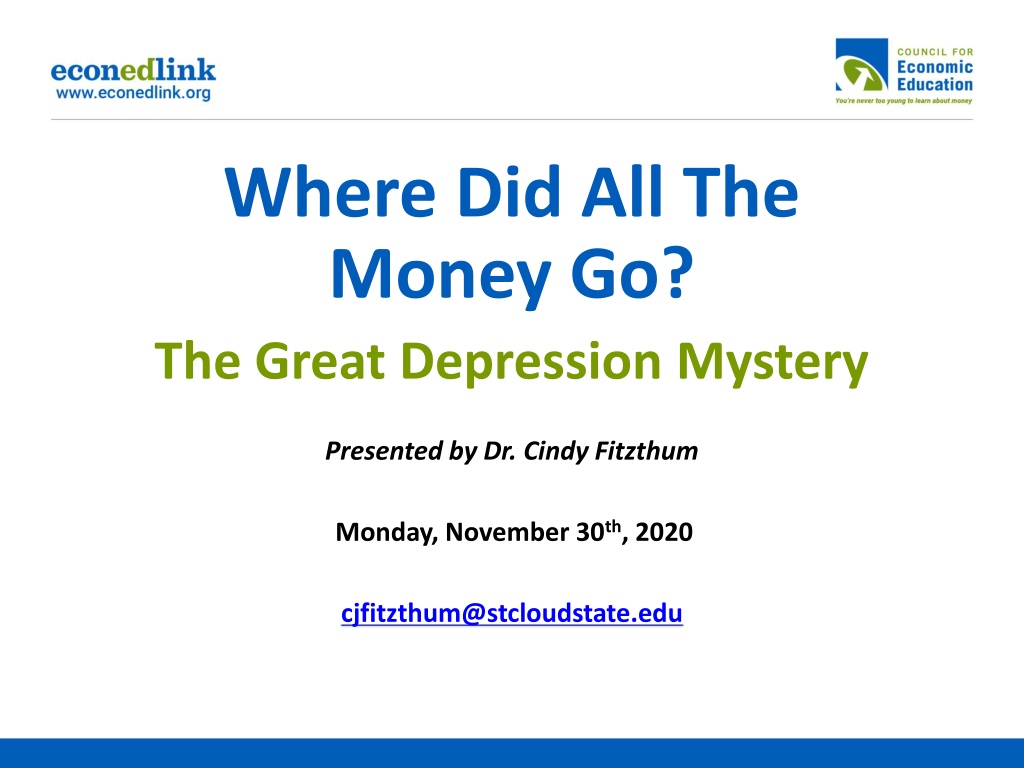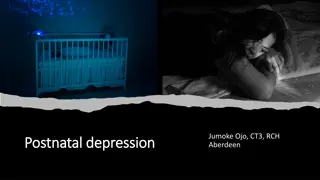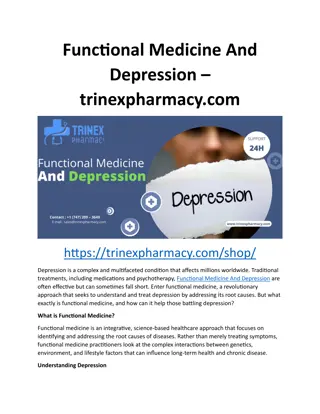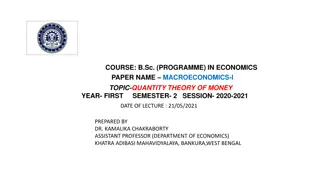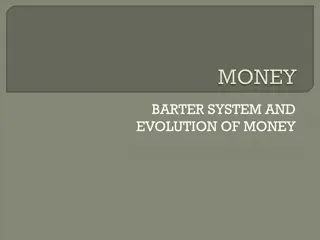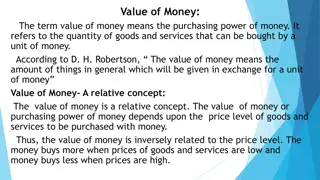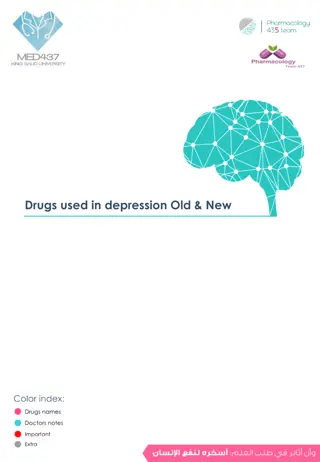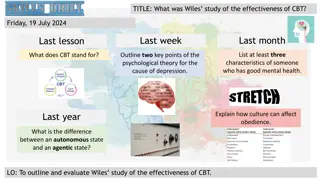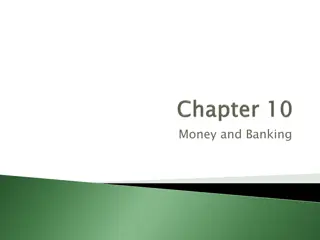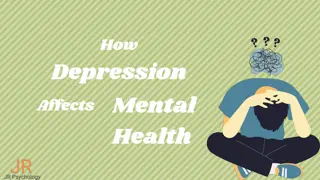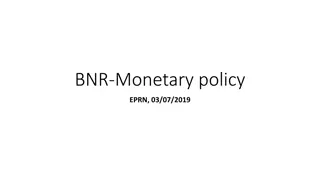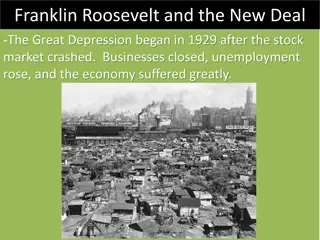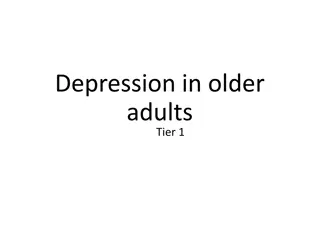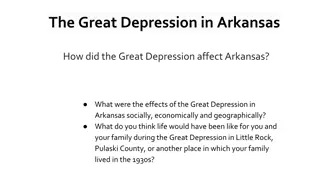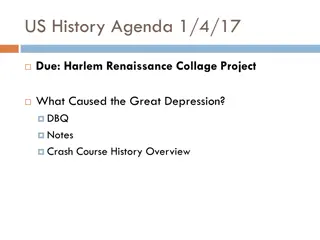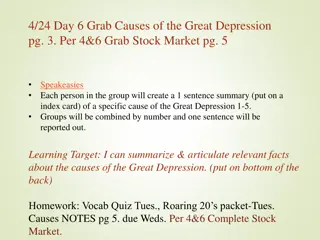Unveiling the Mystery of Where All the Money Went during the Great Depression
Delve into the intriguing investigation led by Dr. Cindy Fitzthum on the economic upheaval of the Great Depression. Explore the impact of Federal Reserve System policies, analyze the relationship between employment and consumer spending, and understand the interdependence within a market economy. Gain insights into economic fluctuations and the role of government in times of crisis.
Download Presentation

Please find below an Image/Link to download the presentation.
The content on the website is provided AS IS for your information and personal use only. It may not be sold, licensed, or shared on other websites without obtaining consent from the author. Download presentation by click this link. If you encounter any issues during the download, it is possible that the publisher has removed the file from their server.
E N D
Presentation Transcript
Where Did All The Money Go? The Great Depression Mystery Presented by Dr. Cindy Fitzthum Monday, November 30th, 2020 cjfitzthum@stcloudstate.edu cjfitzthum@stcloudstate.edu
EconEdLink Membership You can now access CEE s professional development webinars directly on EconEdLink.org! To receive these new professional development benefits, become an EconEdLink member. As a member, you will now be able to: Automatically receive a professional development certificate via e-mail within 24 hours after viewing any webinar for a minimum of 45 minutes Register for upcoming webinars with a simple one-click process Easily download presentations, lesson plan materials and activities for each webinar Search and view all webinars at your convenience Save webinars to your EconEdLink dashboard for easy access to the event You may access our new Professional Development page here
Professional Development Certificate To earn your professional development certificate for this webinar, you must: Watch a minimum of 45-minutes and you will automatically receive a professional development certificate via e-mail within 24 hours. Accessing resources: You can now easily download presentations, lesson plan materials, and activities for each webinar from EconEdLink.org/professional-development/
Agenda Objectives Standards Lesson Overview & Application Ideas Assessments Resources Q and A
Written on Paper or as a Word Document Pause and reflect: Answer the questions Make connections to your situation Question what you want to research further
Objectives Students will be able to analyze the relationship between increases and decreases in employment and consumer spending. Define and identify interdependence within a market economy. Describe how the policies of the Federal Reserve System during the 20s and 30s affected the Great Depression.
National Standards Name: Economic Fluctuations Standard: 18 Students will understand that: Fluctuations in a nation's overall levels of income, employment, and prices are determined by the interaction of spending and production decisions made by all households, firms, government agencies, and others in the economy. Recessions occur when overall levels of income and employment decline. Students will be able to use this knowledge to: Interpret media reports about current economic conditions and explain how these conditions can influence decisions made by consumers, producers, and government policy makers. Name: Role of Government and Market Failure Standard: 16 Students will understand that: There is an economic role for government in a market economy whenever the benefits of a government policy outweigh its costs. Governments often provide for national defense, address environmental concerns, define and protect property rights, and attempt to make markets more competitive. Most government policies also have direct or indirect effects on people's incomes. Students will be able to use this knowledge to: Identify and evaluate the benefits and costs of alternative public policies, and assess who enjoys the benefits and who bears the costs.
National Standards Name: Unemployment and Inflation Standard: 19 Students will understand that: Unemployment imposes costs on individuals and the overall economy. Inflation, both expected and unexpected, also imposes costs on individuals and the overall economy. Unemployment increases during recessions and decreases during recoveries. Students will be able to use this knowledge to: Make informed decisions by anticipating the consequences of inflation and unemployment.
Students will identify conditions in the Students will identify conditions in the economy to learn about the Great economy to learn about the Great Depression. Depression.
YouTube Clip: Its A Wonderful Life Bank Run https://www.youtube.com/watch?v=iPkJH6BT7dM What did you observe? Highlight: Customers of the bank trying to get all of their money out of the bank at once- bank run.
Where did all the money go? Where did all the money go?
During the 1920s enjoyed prosperity (great to talk about equity and cultural changes here). 1920 s, most people in the United States During the 1930 s and unprecedented misery. Why? 1930 s, 12 million people were out of work Reflect Reflect: What might students brainstorm as why ? (Journal and/or use chat now.)
Gregory Mankiw (2003): There are repeated periods during which real GDP falls, the most dramatic being in the early 1930s. Such periods are called recessions if they are mild and depressions if they are more severe. History.com: In 1933 about 25% of the US Workforce is unemployed, Use it up, wear it out, make do or do without motto, potluck entertainment, thrift gardens, Scrabble & Monopoly introduced
Major Reasons Major Reasons: Overproduction, restrictive trade policy, speculation in the stock market based on buying stock on credit, problems with the banking system and tax policy. Started as mild recession, soon became a depression. The amount of money in circulation had drastically decreased. Reflect Reflect: Why did this happen? (Emphasize Mystery!)
Cooperative learning instructional strategy to assess student understanding.
Groups to help solve the mystery! (3 groups) Read WHATDUNIT? (focuses on the 1920s and 1930s). Then, refer to the Almanac: History and Government Website at https://www.infoplease.com/history
1920-1924 1925-1929 1930-1935 Each student researches 5 years on the site and completes the Clue Sheet #1 of that period (Handout) There is a Teacher Guide for your reference
Place students in groups of three --- one per time period --- to share the information with one another, until each student has completed Clue Sheet #1.
EdTech EdTech tool ready for you to use that will engage students in debriefing questions and assist you in checking for understanding understanding. debriefing of the https://create.kahoot.it/share/e944119a-b9c2-4a5d-9ae2- 482997171592
Use the same groups of three and assign each person a section from Clue Sheet #2 Students will again research Reflect Reflect: Students will examine factors and how they contributed to the Great Depression... What might they say/think about labor/employment, poverty, income and government policies?
How are the overall employment trends related to income? Why was farm income depressed throughout the 1920s? What caused the trends in government spending during this time?
What businesses began or grew because of the mass production of the automobile automobile? Suppliers provide all the parts and materials needed to make a car and the car companies assemble those parts Capital Goods: factory, tools, machines Complementary Goods: roads, gas stations, hotels
Understanding how businesses are related to each other.
Understanding how business are related to each other What types of jobs does any business need to function? When these workers earn income from their jobs, what are the three major things that workers do with their income? When income declines, what happens to the three things you identified in the previous question? When demand for cars declined in the late 20s, what kinds of companies business declined?
Assess students by engaging them with a Quizlet Review Game (already created for you on EconEdlink!) https://quizlet.com/354157902/where-did-all-the- money-go-the-great-depression-mystery-flash- cards/
Have students create an Interdependence Web that shows the businesses related to the smartphone revolution. Have students explain the relationships among these businesses and predict what would happen in the economy if interest rates rose by 5% or more.
Assessments 1. Wonderful Life Bank Run Clip 2. WHATDUNIT Reading 3. Almanac: History & Government Website 4. Clue Sheet #1 and #2 (Handouts) 5. Kahoot Game and Quizlet Activities 6. Interdependence Activity See original lesson on EconEdLink did- -all mystery/ mystery/ EconEdLink: : all- -the the- -money money- -go https://econedlink.org/resources/where https://econedlink.org/resources/where- -did go- -the the- -great great- -depression depression- -
CEE Affiliates https://www.councilforeconed.org/resources/local-affiliates/
